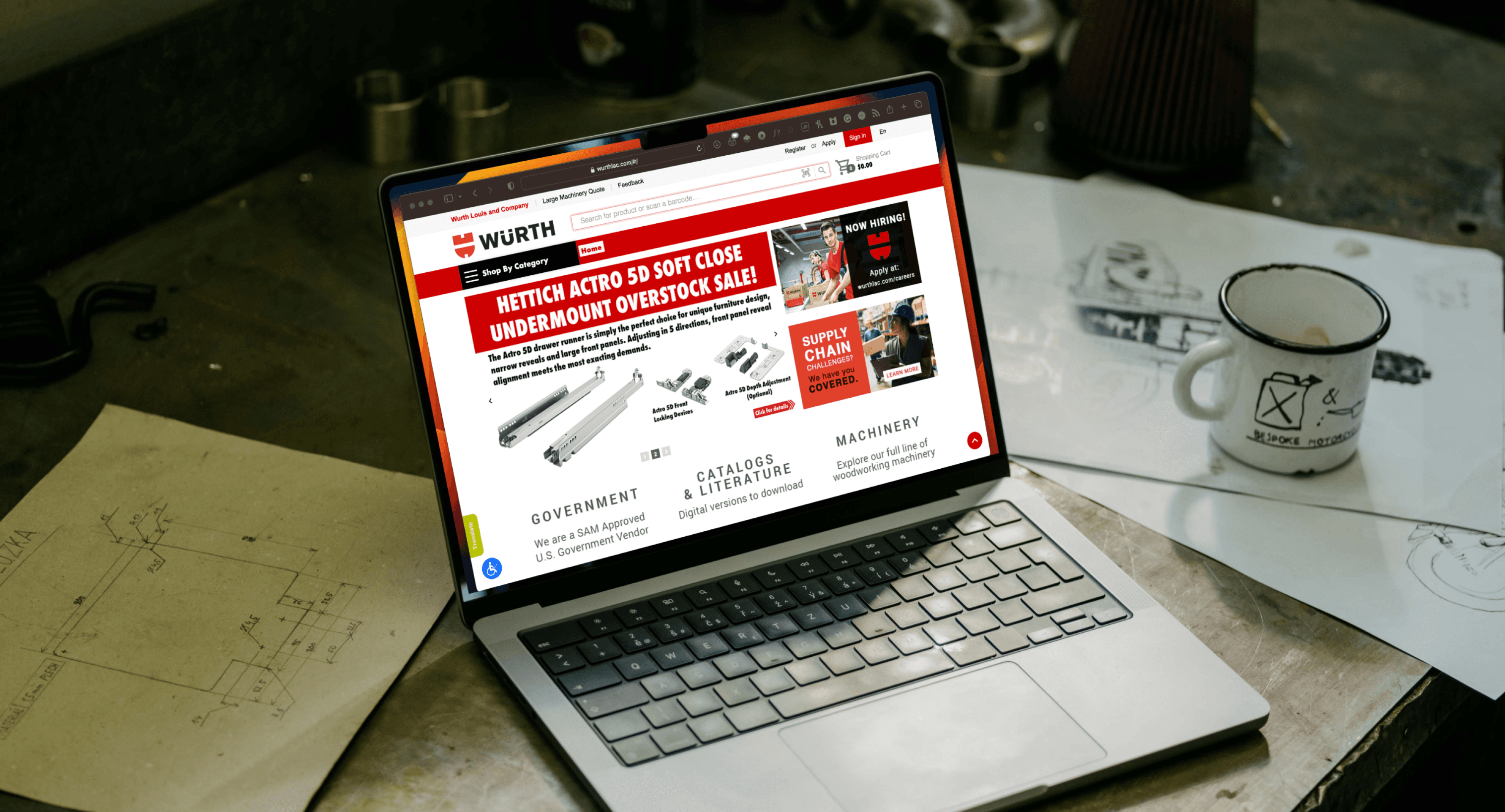WÜRTH LAC: Building a streamlined, scalable, and self-service B2B eCommerce platform

Since joining the Würth Group in 1997, Würth Louis and Company (Würth LAC) has supplied professional woodworkers across the West Coast with quality products from renowned brands. They are supported by a highly trained sales force, a comprehensive product range, and a network of 22 locations across the region and counting.
B2B eCommerce is significantly more complex than its B2C counterpart. A typical product sold by Würth LAC has multiple specifications, variations, adherence to local regulations, compatibility information, availability based on location, shipping specifications, etc. Even something usually standard like product pricing also depends on the order quantity, customer relationships, location, etc.
In addition to this, a standard order placed by a Würth LAC customer comprises more than 30 individual items and a total order quantity that exceeds hundreds.
With all the above to be considered, product orders were traditionally handled by sales representatives and call centre agents who would place the order while in discussions with the client—even registering a customer on the site required a call centre agent’s assistance.
This process, as one can imagine, proved to be quite inefficient for both parties and also left a lot of room for human error. And in this age, the process deterred potential new customers as well.
The Challenge
Despite knowing the problem (and the solution), Würth’s existing legacy platform could not handle further tweaks and upgrades to give its existing customers more freedom, nor was the site showing up to potential new customers.
Their outdated system also opened the door to security threats, along with time-consuming frontend updates.
Customers were faced with a decade-old, monolithic, unintuitive website that was rigid, slow and not mobile-friendly. There was no way to improve the customer experience without significant changes to the system and workflows.
Discovery and Objectives
Würth LAC needed their existing system upgraded to achieve the following business objectives:
- Increase sales revenue.
- Be easily discoverable by their target audiences.
- Improve the customer’s online buying experience.
- Provide customers with the ability to self-manage activities that were being carried out by sales representatives and customer service agents.
- Automate workflows, reducing the workload involved in back-office operations.
- Manage all product information, digital assets and marketing collateral in one central location.
Development
Version 1 was built upon technology and specifications inherited from Würth’s legacy system and began with a large-scale data migration from the legacy system to the new system hosted on Würth's private cloud.
We transitioned from the existing server-rendered (JSP) stack to a client-rendered (React.js) stack, allowing for a faster time to market for frontend updates. Decoupling in general sped up processes on the front and backends as changes could now be made independently.
Using React meant a mobile-friendly site could be more efficiently built, allowing for better accessibility, and marked the beginning of Würth LAC's omnichannel presence. Additionally, a mobile site meant better accessibility for the sector of their target audience who were younger and readily worked on the move, via their smartphone, rather than a laptop or desktop.
Ultimately, Villvay built a self-serve eCommerce platform, comprising 5 subsystems, interconnected via middleware and hosted on Würth’s private cloud:
Pimcore - Manages all product related information (excluding pricing and inventory), including images, specifications, documentation, restrictions, etc.
ERP - Stores all the information related to product pricing and their inventory levels based on each location.
Identity and Access Manager (IAM) - A custom-built IAM to support the user access requirements of the company, since it was not supported out of the box through the headless eCommerce framework.
Headless eCommerce framework - Used to manage critical eCommerce functions used on the site.
Frontend UI - A decoupled eCommerce storefront that connected with the backend using APIs.
Version 1 was the beginning of the modernization of Würth’s legacy systems—and became the launchpad for Version 2, which would happen 2 years later. Maintaining a relationship of understanding and trust with the client meant we were able to refine the system in a collaborative effort.

Version 2 focused on simplifying much of the complexity of Version 1. Villvay applied the principles of MACH architecture (Microservices, API driven, Cloud and Headless) where possible, which made the platform seamlessly scalable.
Both Pimcore and the headless eCommerce framework had similar functionalities and were being used only for very specific purposes, resulting in duplication of data and work, and higher costs.
To rectify this, we upgraded Pimcore, which meant it now supported the functionalities of the previous eCommerce framework. This eliminated the need to use the custom IAM and headless eCommerce framework as separate services on the platform.
The middleware that supported the integration of the 5 subsystems from Version 1 struggled with the complexity of the data being synchronised and failed to provide a single source of truth. Having already streamlined the system by removing the separate IAM and headless eCommerce framework, Villvay then decoupled the communication middleware to enable direct communication between the newly optimized Pimcore, ERP and frontend.
We also set up routine database clean-ups to free up disk space and remove duplicated information. The remaining data was processed by a standalone file sync processor with a dashboard to measure the progress of data synchronization and uploads. This new setup established a true single source of truth for information.
In the time between Versions 1 and 2, Würth had been able to identify some areas that needed to be addressed, such as:
- A lack of a proper audit trail and observability metrics that made it difficult to proactively identify system issues causing downtime and conduct root cause analysis for problems. For this, observability tools were implemented to support MELT (Metrics, Events, Logs and Traces) and distributed request tracing.
- The analytics being generated by the existing system were insufficient to support strategic decision-making by the management. And even these analytics were sourced by business users having to comb through multiple data sets from different systems. This issue was easily combatted by implementing Google Analytics and other third-party analytics services to provide a suite of user and product analytics.
- Würth LAC needed to list their products on other eCommerce sites within the Würth group, utilising them as additional sales channels. To support omnichannel product listings, we used Pimcore as a centralized product information repository.
- Villvay also sped up the customer checkout process by using Pimcore eCommerce to process orders.
Version 2 also marked the start of redeveloping the frontend using an SEO-friendly tech stack that would support web crawlers and page rankings.
And quite significantly, this marked the beginning of Villvay’s Search product, originally built to tackle Würth’s Native Search—which was unintuitive and couldn’t handle the nuances of a product search and link it to the right product, which led to abandoned carts and lost sales.
We introduced attribute filters, facilitating intelligent search features and enhanced native search with Pimcore and Cloud Search middleware. Meaning a user could now search for an item and would also be presented with related items, and the client could program the product to push items on sale etc.
The Results
- Villvay migrated Würth LAC‘s existing 20,000 customers from the legacy system to Würth LAC V1, which by V2 handled 160,000 users and 112,000 SKUs.
- V2 successfully streamlined the original system, opening the door for improved customer experiences, more converted sales, and higher overall visibility for the brand.
